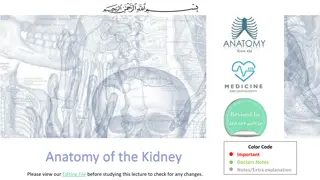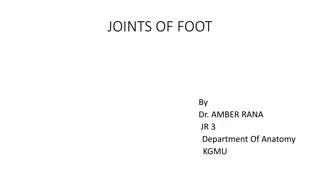Understanding Hemorrhoids: Anatomy, Types, and Treatment
The anal canal anatomy, including internal and external sphincters, blood supply, and classification of internal hemorrhoids are detailed in this informative content. Hemorrhoids, categorized as internal or external, vary in location, symptoms, and treatment options. Understanding the anatomy and types of hemorrhoids is crucial for effective management and treatment.
Download Presentation

Please find below an Image/Link to download the presentation.
The content on the website is provided AS IS for your information and personal use only. It may not be sold, licensed, or shared on other websites without obtaining consent from the author. Download presentation by click this link. If you encounter any issues during the download, it is possible that the publisher has removed the file from their server.
E N D
Presentation Transcript
By: Mohammad Jamjoom Fahad Al-Sabhan Supervised by: Dr. Khayal Al-Khayal
Overview: Anatomy of the anal canal Hemorrhoids Anal fissures Anal abscesses Anal fistulas
The anal canal is 4 cm long It extends from the anal verge to the anorectal junction It is divided into upper and lower halves by the dentate (pectinate) line Above Columnar epithelium Below Squamousepithelium (anoderm) Transitional zone Cuboidal epithelium
Internal (involuntary) and external (voluntary) sphincters The internal sphincter is a thickened continuation of the circular smooth muscles of the rectum (autonomic nervous system) It is responsible for anal continence The external sphincter is a downward extension of the puborectalis muscle (internal pudendal nerve S2-S4)
Blood supply: Arterial supply: Upper half Superior rectal artery Lower half Inferior rectal artery Venous drainage: Upper half Superior rectal vein Portal system Lower half Inferior rectal vein Systemic circulation
Hemorrhoids: They are engorgement of the venous plexi of the rectum, anus or both; with protrusion of the mucosa, anal margin or both Also known as Piles
Types: Internal hemorrhoids External hemorrhoids Above the dentate line Below the dentate line Covered with mucosa Covered with anoderm Painless Painful & itchy May bleed or prolapse Do not bleed, may thrombose
Sites: Left lateral (3 o clock) Right posterior (7 o clock) Right anterior (11 o clock)
Classification of internal hemorrhoids: 1stdegree: Do not prolapse 2nddegree: Prolapsewith straining, but are reduced spontaneously 3rddegree: Prolapsewith straining, but require manual reduction 4thdegree: Cannot be reduced
Etiology: Constipation or straining Increased abdominal pressure Pregnancy Portal hypertension
Signs and symptoms Anal mass or prolapse Bleeding Pruritis Pain or discomfort Sensation of fullness Mucoid discharge and soiling of underwear
Diagnosis: History Rectal examination Proctoscopy Sigmoidoscopyor colonoscopy
DDx: Anal polyps Anal fissures Peri-anal hematoma Rectal prolapse IBD Dermatitis Anorectal carcinoma
Management: Nonoperative (90%): High fiber diet Increase fluid intake Laxatives Avoid straining during defecation Anal hygiene Topical steroids Sitz bath
Surgical (10%): 1stdegree: Sclerotherapy Infra-red photocoagulation Liquid nitrogen cryotherapy 2nddegree: Rubber band ligation 3rdand 4thdegree: Excisional hemorrhoidectomy
Contraindications to surgery: Anticoagulants Portal hypertension and liver cirrhosis class C Crohn'sdisease Anorectal fissures Anorectal infections Anorectal tumors Pregnancy Rectal wall mucosal prolapse
Complications: Exsanguination (bleeding may pool proximally in lumen of colon) Pelvic infection (sepsis) Urinary retention Incontinence (sphincter injury) Anal stricture Abscess
Anal Fissures: They are tears in squamousepithelium of the anus (anoderm) Most common cause of anal pain Most common site is the posterior midline
Etiology: Hard stool or constipation Hyperactive sphincter Disease process (Crohn sdisease)
Signs and symptoms: Tearing pain with defecation Rectal bleeding (blood streaks on toilet paper) Painful rectal examination Sentinel pile (tag) Hypertrophic papilla
Diagnosis: History Rectal examination Proctoscopy
Management: Nonoperative (80%): High fiber diet Increase fluid intake Laxatives Avoid straining during defecation Anal hygiene Topical nifedipine Sitz bath Botox
Surgical (20%): Chronic fissures refractory to conservative treatment Lateral internal sphincterotomy (LIS)
Anal Abscesses and Fistulas They may present as acute or chronic manifestations of the same perirectal disease
Anal Abscess: It s an infection of the soft tissues surrounding the anal canal, with formation of a discrete abscess cavity
Classification of anal abscesses: Perianal (60%) Ischiorectal (20%) Intersphincteric (5%) Supralevator (pelvirectal) (4%) (is very difficult to diagnose clinically and is very rare and caused by inflammation or a disease in the pelvis) Submucosal (1%)
Etiology: Blockage of anal glands which permits the growth of bacteria leading to an abscess formation Common organisms: - Escherichia coli - Enterococcusspecies - Bacteroidesspecies However, no specific bacterium has been identified as a unique cause of abscesses Less common causes:Tuberculosis, squamous cell carcinoma, adenocarcinoma, actinomycosis, lymphogranulomavenereum, Crohn'sdisease, trauma, leukemia and lymphoma
Note: most people have 8 to 10 glands , which are located circumferentially within the anal canal at the level of the dentate line, penetrate through the internal sphincter and end in the intersphincteric plane
Signs and symptoms: Severe pain in the anal area (pain is constant and not necessarily associated with bowel movements) Lump in the anal area Lower abdominal pain (pelvirectal abscess) Constitutional symptoms ( fever, malaise) Drainage of pus
Management: Early incision and surgical drainage of the purulent collection Sitz bath Anal hygiene Laxatives There is no role for antibiotics except for patients who are: - Immunocompromised - Diabetics - Diagnosed with valvular heart diseases - Diagnosed with cellulitis
Complications: A potential complication of anorectal abscess drainage is the formation of fistulous tracts within 6 months in 50% of cases
Anal Fistulas: They are abnormal connections between the epithelialized surface of theanal canal and the perianal skin
Classification of anal fistulas: The 4 categories of fistulas according to Park s classification, based on the relationship of fistula to sphincter muscles, are: Intersphincteric Transphincteric (most common) Supra-sphincteric Extra-sphincteric.
Etiology: Opened perianal or ischiorectal abscesses, which drain spontaneously through these fistulous tracts Fistulas can be found in patients with Inflammatory Bowel Disease (Crohn sdisease) Diverticulitis, foreign body reactions, actinomycosis, chlamydia, lymphogranulomavenereum, syphilis, tuberculosis, radiation exposure and HIV
Signs and symptoms: Recurrent malodorous perianal drainage Pruritus Recurrent abscesses Fever Perianal pain due to an occluded tract, may have pain during defecation
Physical examination: Digital examination is usually all that is required, assessment of the anatomy of an anal fistula is very important Digital examination in a patient with a fistula-in-ano may reveal an indurated tract or cord Fistula can be identified by small circles of granulation tissue, which exudes pus when compressed if tissue is patent A fistulous tract that opens internally can be visualized with aid of an anoscope Inguinal lymph nodes may be enlarged and painful In an acute fistulous abscess, cardinal signs of inflammation, (erythema, pain, increased temperature, edema) may be found
What to asses during physical examination: Often done in the OR External opening Internal opening (Internal opening could be identified during fistula surgery, where we inject hydrogen peroxide (H2O2) & look for internal bubbling or inject methylene blue dye) Course of the tract Amount of sphincter muscle involved
Investigations: CBC (number of WBC in significant infection), blood culture Fistulogram Transanal US MRI CT
Goodsalls rule: One of the most common used principles to assist in surgical management of fistulas Fistulas originating anterior to a transverse line through the anus will course straight ahead and exit anteriorly Whereas, fistulas exiting posteriorly have a curved tract
Management: There are several stages to treating an anal fistula Definitive treatment of a fistula aims to stop it from recurring Treatment depends on where the fistula lies and which parts of the anal sphincter it crosses
Cutting seton Draining seton Fistulotomy Fistula plug Advancement flap
Cutting seton: Is a thick suture placed through the fistula tract and staged pulling is done, so it will allow fibrosis and maintain continence Draining seton: A length of suture material looped through the fistula which keeps it open and allows pus to drain out It only relieves symptoms, and can be used in patients with Crohn s disease
Fistulotomy: A surgical opening of a fistulous tract Fistula plug: Involves plugging the fistula with a device made from small intestinal submucosa
Advancement flap: The internal opening of the fistula is identified and a flap of mucosal tissue is cut around the opening. The flap is lifted to expose the fistula, which is then cleaned and the internal opening is sewn shut. After cutting the end of the flap on which the internal opening was, the flap is pulled down over the sewn internal opening and sutured in place
Intersphincteric fistulae: Primary fistulotomy Low Transsphincteric fistulae: Primary fistulotomy High transsphincteric or anterior fistulae: In female patients should be treated with a more conservative approach, for example a cutting seton or a fistula plug as to avoid fistulotomy incontinence Suprasphincteric fistulae: Advancement flaps, sphincter reconstruction or cutting setons. Fistulotomy should not be performed, to avoid incontinence Extrasphincteric fistulae: Endorectal advancement flap
Contraindications of fistulotomy: Anterior fistulas in females (perform a seton to avoid injuring the perineal body, due to it s proximity) A high level fistula Patients diagnosed with Crohn s disease























